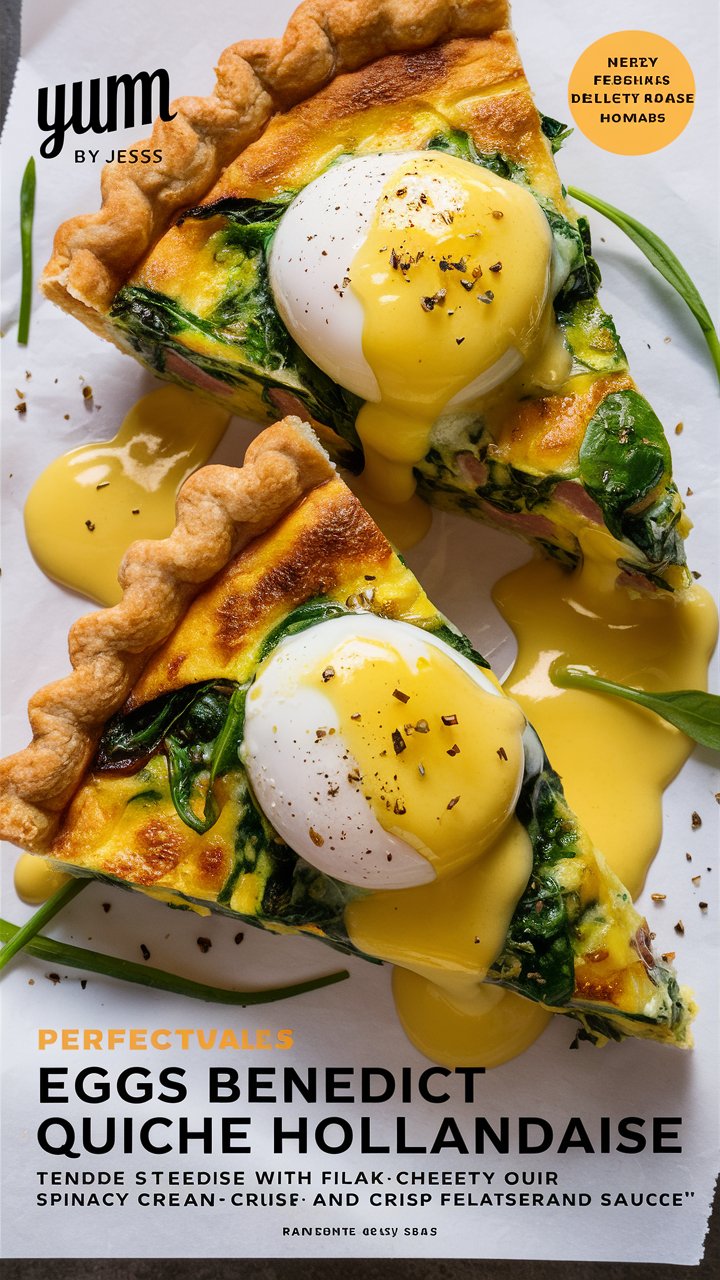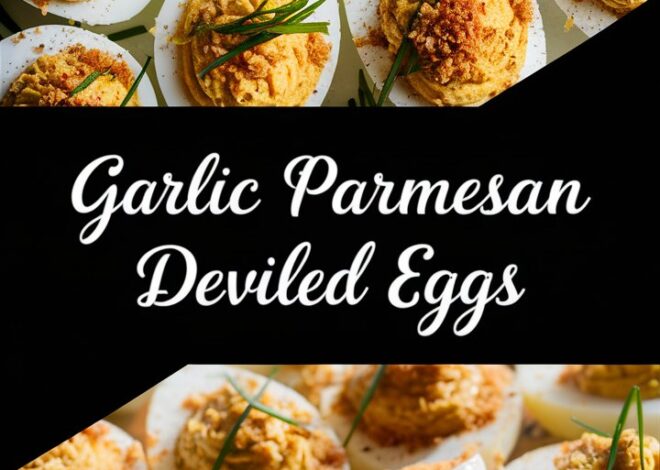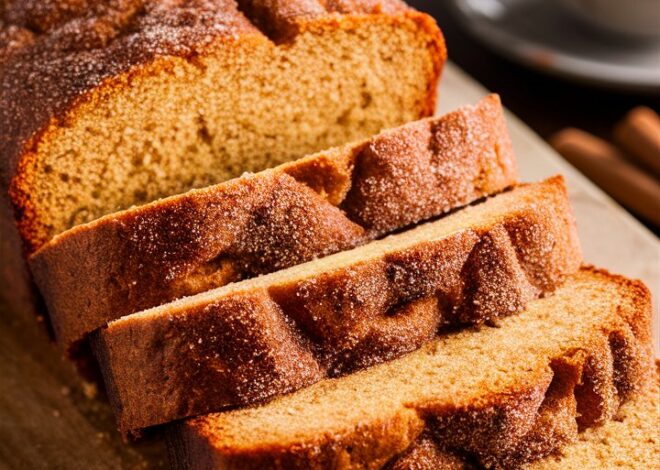
Eggs Benedict Quiche with Creamy Hollandaise: A Chef’s Full Tutorial 2025
Brunch lovers everywhere know the magic of Eggs Benedict: a toasted English muffin topped with Canadian bacon, a perfectly poached egg, and a blanket of silky hollandaise sauce. It’s a dish with French roots, American popularity, and a reputation for being both indulgent and slightly intimidating.
But what if you could enjoy the same decadent flavors without hovering over a pot of simmering water, poaching eggs one by one while guests wait?
Meet the Eggs Benedict Quiche with Hollandaise Sauce—a recipe that transforms a beloved restaurant classic into an easy, make-ahead, slice-and-serve dish that’s perfect for gatherings large or small.
In this in-depth article, you’ll learn:
- The story and culinary principles behind quiche and hollandaise
- How to select and prepare the finest ingredients
- A foolproof method for baking the quiche and blending the sauce
- Make-ahead strategies for busy hosts
- Creative variations, serving ideas, and troubleshooting tips
- Nutritional considerations and practical storage guidance
Whether you’re planning a holiday brunch, a weekend celebration, or simply a luxurious family breakfast, this comprehensive guide will give you confidence and inspiration.
1. Understanding the Dish
A Brief Culinary Background
Quiche, a savory French tart made with eggs and cream baked in pastry, dates back centuries to the region of Lorraine. Traditionally filled with bacon and cheese, it has become a versatile canvas for vegetables, seafood, or nearly any savory filling.
Eggs Benedict, by contrast, is a distinctly American creation of the late 19th century. Its signature hollandaise sauce—a classic French emulsification of butter, egg yolks, and lemon—sets it apart. Combining these two traditions gives you the elegance of French technique and the hearty comfort of American brunch.
Why a Quiche Version Works So Well
- All-in-one preparation: Instead of toasting muffins and poaching eggs à la minute, everything bakes together in one dish.
- Sliceable for sharing: A quiche yields neat wedges, ideal for buffets or sit-down service.
- Better for advance planning: The quiche can be baked the day before, then gently reheated while you prepare the sauce fresh.
- Infinite flavor potential: From smoky bacon to seasonal vegetables, you can customize the filling to suit guests and pantry alike.
2. Ingredients and Equipment
Below you’ll find a carefully balanced ingredient list for one standard 9-inch deep-dish quiche, along with notes on why each item matters. These amounts produce six generous or eight moderate servings.
Core Ingredients
| Category | Ingredient | Quantity | Purpose & Notes |
|---|---|---|---|
| Pastry Base | 9-inch deep-dish pie crust | 1 (frozen or refrigerated) | Choose a quality crust with real butter for the flakiest texture. A store-bought crust keeps the recipe approachable. |
| Custard Filling | Large eggs | 6 | Provide the structure and classic quiche texture. |
| Half-and-half (or equal parts cream and whole milk) | ½ cup + 2 Tbsp | Creates a creamy yet light custard. | |
| Sharp cheddar cheese, shredded | ¾ cup | Delivers robust, tangy flavor. | |
| Parmesan cheese, finely grated | ¼ cup | Adds nutty depth and enhances browning. | |
| Canadian bacon or lean ham, diced | ¾ cup | A nod to the traditional Benedict protein. | |
| Green onions (scallions), thinly sliced | 2 Tbsp | Bright, fresh contrast to the rich custard. | |
| Fresh chives, chopped | 1 Tbsp | Herbaceous lift and garnish. | |
| Sea salt & freshly ground black pepper | to taste | Seasoning balance. | |
| Hollandaise Sauce | Egg yolks | 3 | Form the base of the emulsion. |
| Fresh lemon juice | 1 Tbsp | Provides acidity to balance the butter. | |
| Dijon mustard | ¼ tsp | Subtle depth and stability for the emulsion. | |
| Unsalted butter, melted and hot | ½ cup | The luxurious fat that defines hollandaise. | |
| Warm water | 1–2 tsp as needed | Adjusts consistency. | |
| Pinch of salt (and a dash of cayenne, optional) | to taste | Finishes the sauce. |
Optional Flavor Additions
- Vegetables: Sautéed spinach, blanched asparagus tips, or caramelized onions.
- Cheese Variations: Gruyère for nutty sweetness, or smoked Gouda for depth.
- Herbs: Tarragon, parsley, or thyme for a fresh twist.
Essential Equipment
- 9-inch deep-dish pie plate or a metal tart pan
- Mixing bowls and whisk (or a blender/food processor)
- Baking sheet to catch spills and provide stability
- Saucepan or microwave-safe container to melt butter
- Blender for quick hollandaise (or a double boiler if you prefer classic whisking)
3. Preparing the Quiche
Step 1 – Preheat and Prepare
- Preheat oven to 350°F (175°C) and position a rack in the center.
- If using a frozen crust, keep it chilled until you’re ready to fill. Cold pastry helps prevent sogginess.
Step 2 – Create the Custard
- In a large mixing bowl, whisk together the six eggs and the half-and-half until completely smooth.
- Add cheddar, Parmesan, diced Canadian bacon, green onions, chives, salt, and pepper. Mix gently but thoroughly.
Step 3 – Assemble
- Place the pie crust in its dish and set it on a rimmed baking sheet to catch any overflow.
- Pour the egg mixture into the crust, ensuring an even distribution of solids and liquid.
Step 4 – Bake
- Bake for about 50 minutes, or until the center is just set and the top is lightly golden. A slight jiggle is fine—the quiche will continue to firm as it cools.
- Remove and let it rest for 10–15 minutes before slicing. This brief rest allows the custard to stabilize for clean slices.
4. Crafting the Perfect Hollandaise
Hollandaise sauce has a reputation for being fussy, but a blender method simplifies the process without sacrificing flavor.
- Combine Base Ingredients
Place the egg yolks, lemon juice, and Dijon mustard in the blender. Blend on medium for 10 seconds. - Add Hot Butter
With the blender running on low, slowly drizzle in the hot melted butter in a thin, steady stream. The heat from the butter gently cooks the yolks and forms a silky emulsion. - Adjust Consistency
If the sauce is thicker than you like, add warm water a teaspoon at a time until it reaches the desired pourable texture. - Season and Hold Warm
Taste and season with salt and, if you enjoy a gentle kick, a pinch of cayenne pepper. Keep the sauce warm in a heat-proof bowl set over barely simmering water or cover and set near a warm spot on the stove.
Chef’s Tip: If the sauce separates, don’t panic. Whisk in a teaspoon of warm water or another yolk over gentle heat to bring it back together.
5. Serving and Presentation
Cut the rested quiche into six or eight wedges. Place each slice on a warm plate and spoon hollandaise generously over the top. A scatter of fresh chives or parsley brightens the color and flavor.
Recommended Side Dishes
- Roasted baby potatoes with olive oil and rosemary
- Grilled asparagus or green beans for a crisp, fresh note
- Mixed fruit salad with berries and citrus for sweetness and acidity
- Toasted English muffins or sourdough slices to soak up extra sauce
Pair with freshly brewed coffee, sparkling water, or a classic mimosa for the ultimate brunch experience.
6. Variations and Creative Twists
- Vegetarian Garden Quiche: Replace the meat with sautéed spinach, mushrooms, and diced bell peppers.
- Seafood Delight: Fold in chopped cooked shrimp or lump crabmeat for a coastal vibe.
- Cheese Lover’s Blend: Mix Gruyère, Fontina, and a touch of blue cheese for complex flavor.
- Mini Quiches: Bake the filling in muffin tins for individual servings—great for parties or packed lunches.
- Spicy Kick: Add a hint of smoked paprika or diced jalapeño for a gentle heat.
7. Make-Ahead and Storage Tips
- Bake in Advance: The quiche can be fully baked, cooled, and refrigerated up to 24 hours ahead.
- Freezing: Wrap tightly in plastic and foil and freeze for up to 2 months. Thaw overnight in the fridge before reheating.
- Reheating: Warm slices in a 325°F (160°C) oven for 10–15 minutes.
- Sauce: Hollandaise is best fresh. If you must prepare it early, keep it in a warm spot and whisk occasionally. Avoid freezing.
8. Nutritional Snapshot (Approx. per serving, 1/8 of quiche with sauce)
- Calories: ~330
- Protein: 16 g
- Fat: 23 g (of which saturated ~11 g)
- Carbohydrates: 14 g
- Fiber: 1 g
- Sodium: ~450 mg
These numbers will vary based on crust brand, cheese choice, and sauce quantity. For a lighter dish, use reduced-fat milk, less cheese, and serve sauce sparingly.
9. Troubleshooting Common Problems
| Issue | Likely Cause | Quick Fix |
|---|---|---|
| Soggy crust | Crust not cold or vegetables too wet | Keep crust chilled; pre-cook watery vegetables. |
| Custard cracked | Overbaking | Bake until just set; quiche continues to cook as it rests. |
| Hollandaise separated | Butter too hot or poured too fast | Whisk in warm water or another yolk and blend again. |
| Quiche weeping liquid after cooling | Overcooked eggs | Remove from oven when the center still jiggles slightly. |
10. Hosting a Brunch Around This Dish
For a memorable gathering:
- Plan a balanced menu. Combine this rich quiche with light sides such as citrus salad and herbal iced tea.
- Create a beverage station. Offer coffee, tea, and a sparkling option like mimosas or non-alcoholic spritzers.
- Set the table with warmth. Fresh flowers, simple linens, and small garnish bowls elevate the occasion.
11. Final Thoughts
This Eggs Benedict Quiche with Hollandaise Sauce embodies everything we love about brunch: comfort, elegance, and crowd-pleasing flavor. By folding the poached-egg experience into a single, easy-to-bake dish, it removes stress without sacrificing style.
Follow the techniques here—cold crust, gently mixed custard, and slowly emulsified sauce—and you’ll serve a centerpiece worthy of any celebration, from Mother’s Day and Easter to a quiet weekend morning.
Whether you stick to the classic Canadian bacon and cheddar or branch out with seasonal vegetables and gourmet cheeses, this recipe offers endless possibilities. Slice, drizzle, and enjoy the compliments that follow.


